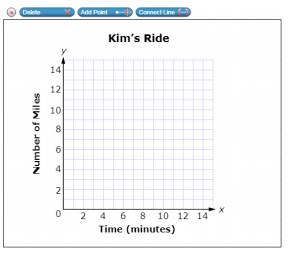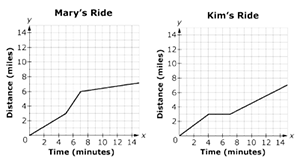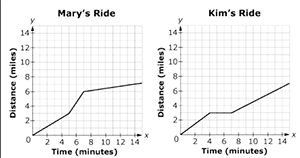Clusters should not be sorted from Major to Supporting and then taught in that order. To do so would strip the coherence of the mathematical ideas and miss the opportunity to enhance the major work of the grade with the supporting clusters.
- Assessment Limits :
Linear or nonlinear relationships may use any of the four quadrants. Graph descriptions move from left to right. Functional relationships must be continuous. - Calculator :
Neutral
- Context :
Allowable
- Test Item #: Sample Item 1
- Question: Which graph represents a linear function increasing at a constant rate?
- Difficulty: N/A
- Type: MC: Multiple Choice
- Test Item #: Sample Item 2
- Question: Kim rides a stationary bike for fifteen minutes of exercise.
Kim starts her ride slowly, stops for 2 minutes, and then continues her ride faster than she started.
Use the Connect Line tool to create a possible graph of Kim’s ride.

- Difficulty: N/A
- Type: GRID: Graphic Response Item Display
- Test Item #: Sample Item 3
- Question:
Mary and Kim go bike riding on some trails. Graphs of the functions representing one of their rides are shown, where x is the time, in minutes, and y is the distance, in miles.
Select all statements that are true based on the graphs shown.

- Difficulty: N/A
- Type: MS: Multiselect
- Test Item #: Sample Item 4
- Question:
Mary and Kim ride their bikes to school each day. Graphs of the functions representing one of their rides are shown, where x is the time, in minutes, and y is the distance, in miles.

Write a short story about Mary’s bike ride describing the relationship between time and distance. Include information about changes in the behavior of the function and rate of speed using terms such as increasing, constant, and decreasing.
- Difficulty: N/A
- Type: OR: Open Response
- Test Item #: Sample Item 5
- Question:
Mary and Kim each take 15 mintues to ride their bikes to school. The graphs of the functions that model their rides are shown, where x is the time, in minutes, and y is the distance, in miles.

The graphs are divided into time intervals A, B, and C.
Use the graphs to match each statement with the appropriate person or people.
- Difficulty: N/A
- Type: MI: Matching Item
Related Courses
Related Access Points
Related Resources
Educational Software / Tool
Formative Assessments
Lesson Plans
Original Student Tutorials
Perspectives Video: Expert
Perspectives Video: Professional/Enthusiasts
Problem-Solving Tasks
Student Center Activity
Teaching Idea
Tutorials
Unit/Lesson Sequences
Virtual Manipulatives
STEM Lessons - Model Eliciting Activity
In this lesson students will categorize a list of stars based on absolute brightness, size, and temperature. Students will analyze astronomical data presented in charts and plot their data on a special graph called a Hertzsprung-Russell Diagram (H-R Diagram). Using this diagram, they must determine the proper classification of individual stars. Using their data analysis, students completing this lesson will develop two short essay responses to a professional client indicating which stars are Main Sequence Stars and which ones are White Dwarfs, Giants, or Supergiants.
MFAS Formative Assessments
Students are given a verbal description of the relationship between two quantities and are asked to sketch a graph to model the relationship.
Students are given a verbal description of the relationship between two quantities and are asked to sketch a graph to model the relationship.
Students are asked to analyze and describe the relationship between two linearly related quantities.
Students are asked to describe the relationship between two quantities in a nonlinear function.
Original Student Tutorials Mathematics - Grades 6-8
Cruise along as you discover how to qualitatively describe functions in this interactive tutorial.
Learn how math models can show why social distancing during a epidemic or pandemic is important in this interactive tutorial.
Student Resources
Original Student Tutorials
Learn how math models can show why social distancing during a epidemic or pandemic is important in this interactive tutorial.
Type: Original Student Tutorial
Cruise along as you discover how to qualitatively describe functions in this interactive tutorial.
Type: Original Student Tutorial
Problem-Solving Tasks
The purpose of this task is for students to interpret two distance-time graphs in terms of the context of a bicycle race. There are two major mathematical aspects to this: interpreting what a particular point on the graph means in terms of the context and understanding that the "steepness" of the graph tells us something about how fast the bicyclists are moving.
Type: Problem-Solving Task
The primary purpose of this task is to elicit common misconceptions that arise when students try to model situations with linear functions. This task, being multiple choice, could also serve as a quick assessment to gauge a class' understanding of modeling with linear functions.
Type: Problem-Solving Task
This is a simple task about interpreting the graph of a function in terms of the relationship between quantities that it represents.
Type: Problem-Solving Task
In this task students draw the graphs of two functions from verbal descriptions. Both functions describe the same situation but changing the viewpoint of the observer changes where the function has output value zero. This small twist forces the students to think carefully about the interpretation of the dependent variable. This task could be used in different ways: To generate a class discussion about graphing. As a quick assessment about graphing, for example during a class warm-up. To engage students in small group discussion.
Type: Problem-Solving Task
In this task students interpret two graphs that look the same but show very different quantities. The first graph gives information about how fast a car is moving while the second graph gives information about the position of the car. This problem works well to generate a class or small group discussion. Students learn that graphs tell stories and have to be interpreted by carefully thinking about the quantities shown.
Type: Problem-Solving Task
Student Center Activity
Students can practice answering mathematics questions on a variety of topics. With an account, students can save their work and send it to their teacher when complete.
Type: Student Center Activity
Tutorials
In this tutorial, students will compare linear functions from a graph. Students should have an understanding of slope and rate of change before reviewing this tutorial.
Type: Tutorial
This tutorial shows how to compare linear functions that are presented in both a table and graph. Students should have an understanding of rate of change before viewing this video.
Type: Tutorial
Students will compare linear functions presented in a graph and in a table. Students should have a strong understanding of rate of change before viewing this tutorial.
Type: Tutorial
In this tutorial, you will look at several real-world examples of linear graphs and interpret the relationship between the two variables.
Type: Tutorial
Virtual Manipulatives
Allows students access to a Cartesian Coordinate System where linear equations can be graphed and details of the line and the slope can be observed.
Type: Virtual Manipulative
In this online tool, students input a function to create a graph where the constants, coefficients, and exponents can be adjusted by slider bars. This tool allows students to explore graphs of functions and how adjusting the numbers in the function affect the graph. Using tabs at the top of the page you can also access supplemental materials, including background information about the topics covered, a description of how to use the application, and exploration questions for use with the java applet.
Type: Virtual Manipulative
This interactive simulation investigates graphing linear and quadratic equations. Users are given the ability to define and change the coefficients and constants in order to observe resulting changes in the graph(s).
Type: Virtual Manipulative
Parent Resources
Problem-Solving Tasks
The purpose of this task is for students to interpret two distance-time graphs in terms of the context of a bicycle race. There are two major mathematical aspects to this: interpreting what a particular point on the graph means in terms of the context and understanding that the "steepness" of the graph tells us something about how fast the bicyclists are moving.
Type: Problem-Solving Task
The primary purpose of this task is to elicit common misconceptions that arise when students try to model situations with linear functions. This task, being multiple choice, could also serve as a quick assessment to gauge a class' understanding of modeling with linear functions.
Type: Problem-Solving Task
This is a simple task about interpreting the graph of a function in terms of the relationship between quantities that it represents.
Type: Problem-Solving Task
In this task students draw the graphs of two functions from verbal descriptions. Both functions describe the same situation but changing the viewpoint of the observer changes where the function has output value zero. This small twist forces the students to think carefully about the interpretation of the dependent variable. This task could be used in different ways: To generate a class discussion about graphing. As a quick assessment about graphing, for example during a class warm-up. To engage students in small group discussion.
Type: Problem-Solving Task
In this task students interpret two graphs that look the same but show very different quantities. The first graph gives information about how fast a car is moving while the second graph gives information about the position of the car. This problem works well to generate a class or small group discussion. Students learn that graphs tell stories and have to be interpreted by carefully thinking about the quantities shown.
Type: Problem-Solving Task
Teaching Idea
This resource features two pairs of interactive graphs to help students explore rate of change and linear relationships. "Users can drag a slider on an interactive graph to modify a rate of change (cost per minute for phone use) and learn how modifications in that rate affect the linear graph displaying accumulation (the total cost of calls). In this first part, Constant Cost per Minute, the cost per minute for phone use remains constant over time. In the second part, Changing Cost per Minute, the cost per minute for phone use changes after the first sixty minutes of calls." (from NCTM's Illuminations)
Type: Teaching Idea
Virtual Manipulative
Allows students access to a Cartesian Coordinate System where linear equations can be graphed and details of the line and the slope can be observed.
Type: Virtual Manipulative









